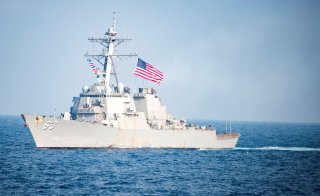To Win a War with China, the Military Should Embrace Digital Wargaming
The value of multi-domain educational learning from wargaming cannot be overstated.
Damien O’Connell, the founder of the Warfighting Society, recently penned an article, “Progress and Perils: Educational Wargaming in the US Marine Corps,” on The Maneuverist blog, which delineated implementation issues for fleet-wide educational gaming. He outlines five obstacles to greater implementation of wargaming in the operating forces: “(1) confusion about what educational wargaming is and is not, (2) skepticism of its value, (3) ignorance of its successful use, (4) limited time, (5) aversion to nerd culture, and (6) ignorance of how to integrate wargames into training and education plans.” The Navy and USMC must not conflate educational gaming with analytical wargaming. Decision-making opportunities and force design instruction found in basic wargames will answer any confusion surrounding wargaming and its value and demonstrate its successful use to any observing critics. However, overcoming issues related to time and integration will demand a substantial initial investment and revised time requirements through curriculum standardization. Aversion to “nerd culture” stems from a historical stigma against board gaming, shared even by video gamers; this dislike can be easily solved by tapping into the voracious appetite for video games.
A secondary benefit of creating wargame literate junior officers would positively boost the ability of time-proven analytical gaming and thus improve force design and doctrine. The early introduction of wargames will create “a bigger pool of individuals who are exposed to the principles of wargaming, allowing the DOD to cast a wider net when looking for qualified individuals to build, run, and analyze games,” and in turn, increase the performance of future professional analytical wargaming. Furthermore, the over-reliance on civilian-run wargames has created a capability deficit among military personnel, because fewer are trained in how to run and manage wargames. This culture change could imitate the drastic success of the Prussian officer corps, which spawned avid wargamers such as General von Moltke—the Prussian army chief of staff—who expanded the use of wargaming under his leadership. As a result, the Prussian military dominated the European continent in the 19th century and forged a dominant military doctrine that lasted a century. Unsurprisingly, “many countries attributed the battlefield success of Moltke and the Prussians to the integration of wargaming in their army.”
Junior officer education needn’t be limited to monotonous PowerPoint displays or exclusive to PME. Wargaming presents a straightforward remedy for a complex educational challenge and should not be dismissed as an after-school activity. If the US military aims to regain the edge against the PLA in critical thinking and education, it must create a finely tuned educational military simulation video game. Furthermore, the potential for training will exponentially grow as technology such as virtual reality becomes more readily available. The Navy and USMC must stay ahead of the educational curve, set the foundation for a future sophisticated Ender’s Game-like military simulation or Star Trek’s morality-testing unwinnable game, the Kobayashi Maru, and turn science fiction into reality. Existing tabletop games may temporarily suffice but must be formally integrated into the curriculum and eventually replaced by digital simulations. The value of multi-domain educational learning from wargaming cannot be overstated. Moreover, increased interaction with younger generations through a popular Navy-endorsed video game could help draw in technology-oriented recruits. The Navy and USMC must embrace 21st-century technology and adapt it to benefit instruction for foreseeable near-peer threats. No military aviator argues against the extensive use of flight simulators in modern instruction; this attitude must be broadened to the entire Fleet.
LT Jack Tribolet flew the MH-60S Knighthawk with HSC-26 out of Norfolk. He currently serves as an Officer Instructor teaching at the University of Southern California and is the nationwide NROTC Course Coordinator for the class Seapower & Maritime Affairs.
This article was first published by CIMSEC.

